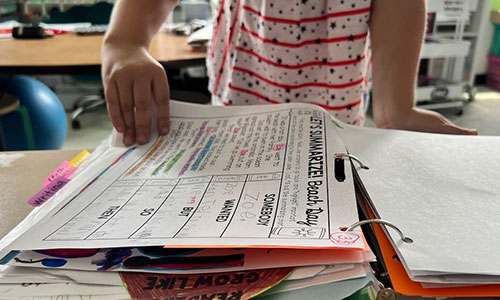
In “5 grounding tenets for successful instructional coaching relationships,” my colleague Lindsay Deacon explored the five grounding tenets that shape effective instructional coaching: prioritize agency, offer partnership, center on equity, honor experience, and foster relationships. As virtual instructional coaching becomes increasingly prevalent, it’s essential to consider how these tenets can be effectively applied in a digital context. While the core principles remain the same, their implementation requires thoughtful adaptation to the virtual environment.
Tenet 1: Prioritize agency
This first tenet centers on empowering teachers to be active, valued, and equal members of an instructional coaching relationship and to make the most of professional learning opportunities.
Virtual application
Empowering teachers to prioritize their professional learning in a virtual setting involves providing flexible and accessible resources. Coaches can use various digital tools to offer personalized support that fits a teacher’s schedule and preferences. The key difference from in-person coaching is the need to be more proactive in offering diverse and easily accessible resources to accommodate varying levels of comfort and familiarity with technology.
Strategies
- Asynchronous learning opportunities: Create and share video tutorials, articles, and online courses that teachers can access at their convenience. This differs from in-person coaching, where learning might occur more synchronously.
- Virtual check-ins: Schedule regular, flexible virtual meetings to discuss progress, set goals, and address any challenges teachers might face. Virtual check-ins should be more frequent to compensate for the lack of physical presence and spontaneous interactions. Aim to check in at least once a week, even if it’s just a five-minute chat. Consistency is key.
- Digital collaboration tools: Utilize platforms like FigJam, Miro, Mural, or Kami to collaboratively work on plans and projects, ensuring teachers have a say in their professional development journey. These tools help maintain an ongoing collaborative environment, unlike sporadic in-person meetings.
Reflection questions
- How can I leverage digital tools to honor and value the skills, knowledge, and talent of those I coach?
- How can I ensure that my virtual coaching practices enable others to grow and achieve their potential?
Tenet 2: Offer partnership
As Lindsay explains in her post, “Coaches and teachers must work together toward a common goal: student learning.” Functioning as a team can make instructional coaching infinitely more successful.
Virtual application
In the virtual realm, fostering a collaborative coaching partnership requires intentional communication and shared digital spaces. Unlike in-person coaching, where non-verbal cues and spontaneous conversations play a significant role, virtual instructional coaching relies heavily on structured communication and regular check-ins to maintain a strong partnership.
Strategies
- Joint virtual planning sessions: Use video conferencing tools to co-plan lessons and strategies in real time. This approach can mirror in-person collaborative planning sessions, with the added benefit of allowing you to record sessions for future reference.
- Feedback loops: Implement regular feedback mechanisms through digital surveys, emails, or discussion boards to maintain a two-way dialogue. This ensures continuous engagement and responsiveness, which can be more challenging to gauge without face-to-face interaction.
- Co-teaching opportunities: If feasible, join virtual classrooms to co-teach or observe virtually and provide immediate, constructive feedback. Another alternative is to utilize recording and analysis using a “look-for” protocol. This can be done individually and then collaboratively discussed. Utilizing a “look-for” protocol can help teachers focus on specific information rather than superficial critiques. If you don’t already have tried and true “look-for” protocols, Corwin has a helpful one to assess student behavior and another teachers can use to assess instruction.
Reflection questions
- How can I use virtual tools to recognize that working together is essential to creating anything significant?
- What does taking joint responsibility look like in a virtual coaching environment?
Tenet 3: Center on equity
Our busy schedules can sometimes make it easy to overlook the importance of equity in instructional coaching. But as Lindsay rightly asserts, “Teaching is extremely personal, and coaches must be able to enter their work with an asset-based mindset.”
Virtual application
Equity in a virtual coaching context means ensuring that all teachers have access to the resources and support they need to succeed, regardless of their technological proficiency or access. The virtual environment can amplify existing disparities, so coaches must be vigilant in addressing these challenges.
Strategies
- Technology support: Provide training sessions on using virtual platforms effectively to ensure all teachers can fully participate. This might include offering one-on-one tech support or creating how-to guides and FAQs. However, keep in mind that technology is a tool for learning, not a learning outcome.
- Resource distribution: Ensure that digital resources are accessible to all, considering potential barriers such as accessibility needs, time constraints, and language barriers. This could involve providing resources that are compatible with assistive technologies, making resources available on demand to accommodate teachers’ schedules, and providing translations or resources in multiple languages.
- Personalized coaching: Tailor coaching sessions to meet the specific needs of each teacher, acknowledging and addressing their unique challenges. In a virtual setting, this means being more flexible and adaptable to different time zones, schedules, and levels of digital fluency. It may also mean offering materials in multiple formats to cater to different learning styles.
Reflection questions
- How can I develop better virtual connections to—and concern for—those I coach?
- How do I demonstrate the worth and dignity of those I coach through virtual interactions?
Tenet 4: Honor experience
One of the biggest benefits of instructional coaching is the opportunity to tailor the experience to the unique individual you’re working with. Understanding a teacher’s experience in the classroom is critical.
Virtual application
Honoring experience in a virtual setting involves creating relevant and practical learning experiences that translate well into the digital classroom. The lack of physical presence requires more creativity in making these experiences engaging and effective.
Strategies
- Interactive webinars: Host webinars that allow for interactive participation, such as Q&A sessions and breakout discussions. Unlike traditional workshops, these webinars need to be more dynamic to keep participants engaged. Incorporate multimedia elements, interactive quizzes, and real-world examples to enhance engagement and relevance.
- Virtual peer observations: Facilitate opportunities for teachers to observe other classrooms virtually (in real time or recorded). Encourage teachers to share insights, resources, and experiences related to their students’ needs and learning outcomes, fostering collaboration and collective problem-solving. This provides valuable cross-learning opportunities.
- Case study analysis: Encourage teachers to engage in case study analysis, where they examine specific teaching scenarios, strategies, or student outcomes within their classrooms. They can reflect on these cases, analyze what worked well, identify areas for improvement, and share their insights. Virtual platforms can facilitate the sharing and discussion of these case studies more broadly and effectively.
Reflection questions
- How do I foster authentic and supportive virtual experiences to encourage teachers to experiment, explore, and take risks?
- How do I encourage those I coach to practice the skills they are learning so they can achieve mastery in a virtual setting?
Tenet 5: Foster relationships
“When coaches anchor their work with teachers in a respect that is fostered by actively listening to each other,” Lindsay explains, “they will develop a reciprocal, trusting relationship where the outcomes truly matter to both the coach and the teacher.”
Virtual application
Building and maintaining strong relationships virtually requires a deliberate effort to establish trust and rapport through consistent and meaningful communication. Without the benefit of face-to-face interaction, coaches must be more intentional in creating opportunities for connection.
Strategies
- Regular virtual meetings: Schedule consistent virtual meetings to check in, listen, and provide feedback. Frequency is key to compensate for the lack of casual, spontaneous interactions typical in an in-person setting. Consistency helps build routine and reliability. Have a clear agenda for each meeting but allow flexibility to address immediate concerns or questions from the teachers.
- Personal touches: Use personalized messages, video calls, and digital notes to show genuine interest and care. Small gestures, such as remembering personal details and celebrating successes, become even more important virtually.
- Virtual social gatherings: Organize informal virtual gatherings or coffee chats to build a sense of community and connection. These gatherings can help recreate the camaraderie of in-person interactions and reduce feelings of isolation.
Reflection questions
- How do my virtual interactions exhibit respect and personal regard through listening, questioning, and providing feedback?
- How do I use language that demonstrates a belief in the contributions of those I coach in a virtual environment?
In closing
Transitioning to virtual instructional coaching presents unique challenges and opportunities. By applying the five grounding tenets—prioritize agency, offer partnership, center on equity, honor experience, and foster relationships—coaches can continue to provide effective, meaningful support in the digital realm. Embracing these principles ensures that virtual coaching remains impactful, helping teachers grow professionally and enhancing student learning outcomes.
As we navigate this digital shift, continuous reflection and adaptation will be key. Let’s commit to using these tenets as our guide to create resilient and responsive virtual instructional coaching environments where all educators and students can thrive.
To learn more about instructional coaching services available through NWEA, visit our website.






